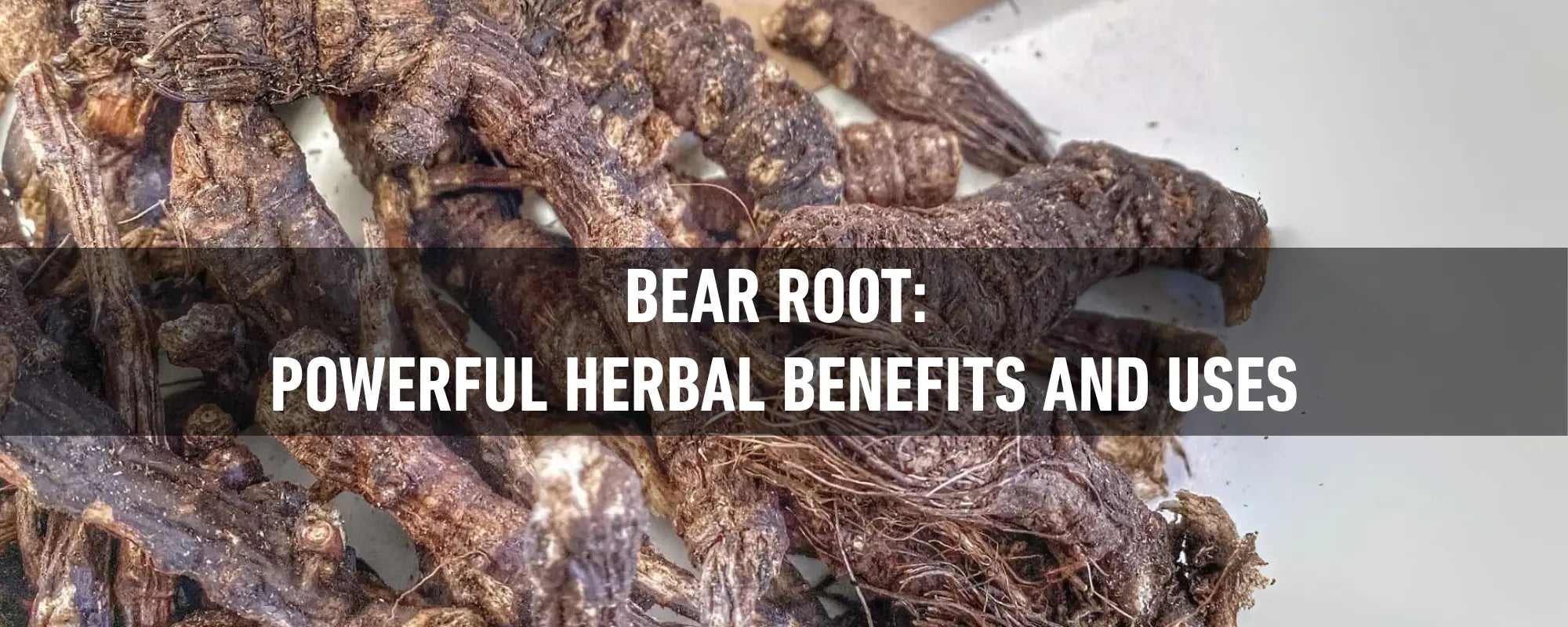Bear Root Benefits: Complete Guide to Osha Root Uses & Health Support
Bear Root, also known as Osha Root, has long been used as a medicinal herb, particularly in Native American medicine. Known for its strong aroma and earthy flavor, Bear Root is a versatile herb renowned for its ability to support respiratory health, boost immunity, aid digestion, and reduce inflammation. In this comprehensive guide, we'll explore the many benefits of Bear Root, its traditional uses, and how to incorporate it thoughtfully into your wellness routine.
Explore the Sacred Traditions of Bear Root: Beyond its physical healing properties, Osha Root holds deep spiritual significance in Indigenous ceremonies and folk practices. Discover the spiritual and ceremonial uses of Osha Root for protection, cleansing, and sacred rituals that have been honored for generations.
What is Bear Root?

Osha Root (Bear Root) — Whole
Ethically wildcrafted from high-elevation Rocky Mountain meadows. Traditional Bear Root for respiratory support, immune wellness, and spiritual practice.
View Bear RootUnderstanding the Origin of Bear Root
Bear Root, commonly referred to as Osha Root, is native to the Rocky Mountains and other high-altitude regions of North America. It has been used for centuries by Indigenous cultures for its medicinal properties. Traditionally, it was chewed or brewed as a tea to treat various ailments, especially respiratory issues and infections. The plant's Latin name, Ligusticum porteri, reflects its botanical classification within the Apiaceae (parsley) family.
Why is Bear Root Called Osha Root?
The terms Bear Root and Osha Root are often used interchangeably. The herb earned its nickname "Bear Root" because bears are known to dig up and chew the roots, particularly after hibernation, likely to support their recovery and immunity after months of dormancy. Regardless of the name, Bear Root has become popular in modern herbal medicine due to its numerous traditional health benefits and its respected place in ethnobotanical history.
Top Health Benefits of Bear Root
1. Respiratory Support and Relief
Bear Root is best known for its effectiveness in supporting respiratory health. Its warming and stimulating properties help clear the respiratory tract, making it ideal for traditional use during colds, bronchial congestion, and other respiratory discomfort. It acts as an expectorant, helping to loosen mucus and making it easier to expel, providing relief for conditions like bronchitis, seasonal colds, and sore throats. The aromatic volatile oils in Bear Root contribute to its reputation as a respiratory ally in herbal medicine.
2. Immune System Support
Bear Root's antimicrobial and antiviral properties make it a valued immune support herb in traditional use. It helps the body's natural defenses respond to seasonal challenges. Using Bear Root during cold and flu season is a time-honored practice in many herbal traditions. Modern herbalists often recommend it as part of a comprehensive wellness routine that includes proper rest, nutrition, and stress management.
3. Digestive Aid and Stomach Soother
Bear Root is also known for its traditional digestive benefits. It can help ease bloating, reduce gas, and soothe an upset stomach. The herb's warming properties make it beneficial for those who experience digestive discomfort, especially after heavy meals. In folk herbalism, warming herbs like Osha Root are valued for their ability to stimulate digestive fire and promote comfortable digestion.
4. Anti-Inflammatory and Pain Relief
Bear Root contains natural anti-inflammatory compounds that traditional herbalists value for their ability to ease discomfort, particularly in the joints and muscles. This makes it a useful herb for those seeking natural approaches to inflammatory conditions. The combination of warming properties and aromatic compounds creates a synergistic effect that many users find soothing.

How to Use Bear Root Effectively
Popular Ways to Take Bear Root
Bear Root can be consumed in various forms, each offering different advantages:
- Tinctures: For quick absorption, add tincture drops to water or tea. Tinctures preserve the volatile oils and offer a convenient way to use Bear Root daily.
- Capsules: Easy to incorporate into daily routines for consistent support. Capsules provide standardized dosing and eliminate the strong taste.
- Powder: Mix into teas, smoothies, or food for digestive relief and overall health benefits. Powder can be added to warm beverages or encapsulated at home.
- Teas & Decoctions: Brew Bear Root in hot water for soothing respiratory and digestive benefits. Traditional preparation involves simmering the root for 15-20 minutes to extract its beneficial compounds.
Recommended Dosage and Precautions
Important Safety Information
When using Bear Root, it's important to start with small doses and gradually increase as needed. Consult a healthcare provider before using Bear Root, especially if you are pregnant or nursing, or if you have specific health concerns. Avoid excessive consumption, as it may cause digestive upset in sensitive individuals.
Safety Tip: Always follow the recommended dosage listed on Sacred Plant Co's Bear Root products to ensure safe and effective use. This information is for educational purposes only and is not medical advice.
Bear Root Respiratory Support Tea Recipe

Traditional Respiratory Support Tea Blend
This simple yet effective tea blend featuring Bear Root is designed to support respiratory health, reduce inflammation, and promote immune function using time-honored herbal combinations.
Ingredients:
- 1 tsp Bear Root (Osha Root) ($5.85)
- 1 tsp Mullein Leaf ($12.07)
- 1 tsp Peppermint ($16.48)
- 1 cup hot water (just off boil, around 200°F)
Instructions:
- Combine all herbs in a tea infuser, heatproof bowl, or French press.
- Pour hot water over the herbs and cover to trap volatile oils.
- Steep for 10-15 minutes for optimal extraction.
- Strain thoroughly, let cool slightly to comfortable drinking temperature, and enjoy once daily to support respiratory and immune health.
Benefits: This tea combines Bear Root's immune and respiratory support with Mullein's traditional lung-clearing effects and Peppermint's soothing properties, making it ideal for seasonal respiratory wellness support.
Variation: Add honey and lemon for additional soothing properties and improved taste. For enhanced immune support, consider adding a slice of fresh ginger.
Comparing Bear Root with Other Medicinal Herbs
Bear Root vs. Other Immune-Supporting Herbs
Bear Root's benefits are often compared to other popular immune-supporting herbs in traditional herbalism:
- Echinacea ($10.98): Known for traditional use in reducing the severity of colds, Echinacea supports immunity similarly to Bear Root but is primarily focused on upper respiratory challenges.
- Astragalus ($10.64): This adaptogenic herb supports immunity with a focus on overall immune balance and long-term wellness rather than acute respiratory clearing.
- Elderberry ($16.55): Effective for traditional immune support and cold prevention, Elderberry provides antioxidant support but lacks the respiratory-clearing properties of Bear Root.
For a more comprehensive approach to wellness, consider combining Bear Root with other herbs like Echinacea Extract ($9.77) or Astragalus Root ($12.99) as part of a holistic herbal protocol.
Embrace the Benefits of Bear Root
Bear Root offers a natural way to support respiratory health, boost immunity, aid digestion, and address inflammation through traditional herbal practice. Whether you're looking for relief from congestion, immune support during seasonal changes, or digestive benefits, Bear Root is a powerful addition to your wellness routine when used mindfully and with respect for its traditional applications.
Continue Your Journey with Bear Root: To fully appreciate this sacred plant, explore how Osha Root has been used in spiritual practices, protection ceremonies, and energy work across Indigenous and folk traditions. Understanding both the physical and spiritual dimensions of this plant deepens our connection to traditional wisdom.
Bear Root (Osha Root) FAQ
What is Bear Root (Osha Root)?
Bear Root, also called Osha Root (Ligusticum porteri), is a high-altitude herb native to the Rocky Mountains. In traditional Native American and folk herbalism, it's used for seasonal respiratory support and general wellness practices.
What are the traditional benefits of Bear Root?
Traditionally, Osha Root is used as a warming, aromatic herb to support the respiratory tract, encourage healthy mucus flow, and comfort the throat. It's also used in wellness routines for immune and digestive support based on centuries of traditional use.
How do you take Bear Root?
Common formats include tinctures (drops in water or tea), capsules (for convenience), powders (in smoothies or warm water), and teas/decoctions (simmered slices or powder). Choose the form that best fits your routine and lifestyle.
How do I make Bear Root tea?
Steep 1 teaspoon dried Bear Root (or a few thin root slices) in 8 oz hot water for 10–15 minutes. For a classic respiratory blend, add mullein and peppermint as shown in our recipe above. Always strain before drinking.
What does Bear Root taste like?
It has a strong, earthy, resinous flavor with a warming finish. The taste is distinctive and powerful. Honey and lemon can soften the edges without masking its characteristic warming properties.
What is a typical dosage?
Start low and assess your response. For teas, begin with 1 cup daily; for tinctures, follow the product label (often a dropperful in water up to 2–3 times daily). Always follow your product's specific directions and consult a healthcare professional.
Who should avoid Bear Root?
Do not use during pregnancy or nursing unless guided by a qualified professional. If you take medications, have a medical condition, or are allergic to Apiaceae family plants (carrot/celery/parsley family), consult your healthcare provider first.
Are there side effects or interactions?
Large amounts may cause digestive upset in sensitive individuals. Because Osha is aromatic and stimulating, pair with professional guidance if you're managing a health condition or using prescription medications.
Why is it called "Bear Root"?
Traditional stories describe bears digging and chewing the roots—especially after hibernation—to support their recovery and health, leading to the common name. "Osha" and "Bear Root" refer to the same plant (Ligusticum porteri).
How do I store Osha Root?
Keep dried root or powder in an airtight container, away from heat, light, and moisture. Proper storage in a cool, dark place preserves potency, aroma, and shelf life. Glass jars with tight-fitting lids work well.
Educational Notice: The information above is for educational purposes only and is not medical advice. Always consult your healthcare professional before using new herbs, especially if pregnant, nursing, or on medication. Statements about traditional use are not evaluated by the FDA. These products are not intended to diagnose, treat, cure, or prevent any disease.





